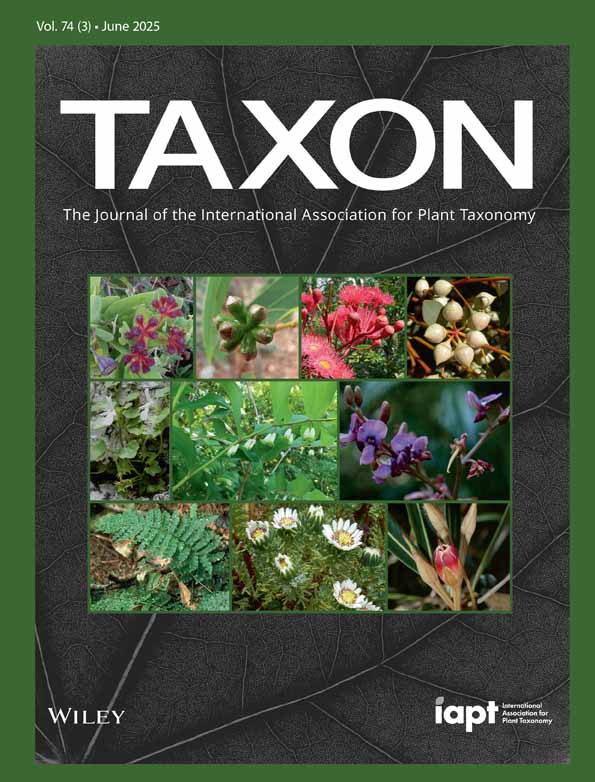(3083) Proposal to conserve the name Ophioglossum flexuosum (Lygodium flexuosum) (Lygodiaceae) with a conserved type
Proposals to Conserve or Reject Names edited by John H. Wiersema, Konstanze Bensch, Melanie Schori & John McNeill
(3083) Ophioglossum flexuosum L., Sp. Pl.: 1063. 1 Mai 1753, nom. cons. prop.
Typus: India, Kerala, roadside near Amboori, E. of Neyyar Dam […], E. of and above Tiruvananthapuram (Trivandrum), 4 Mar 2007, Fraser-Jenkins 32713 [FN 19] (TAIF [on 2 sheets with sterile (No. 390469) & fertile (No. 390470) frond fragments]), typ. cons. prop.
The genus Lygodium Sw. is a well-defined monophyletic group of ferns encompassing, according to various estimates, 22–49 species. They display a combination of characters that is unique among extant ferns. Lygodium is one of only two genera of twining ferns (the other one is a small genus Salpichlaena J. Sm. [Blechnaceae]) (Kramer in Kramer & Green, Fam. Gen. Vasc. Pl. 1: 258–263. 1990; Pelosi & al. in Amer. J. Bot. 111: e16389. 2024). Species of Lygodium produce very large fronds that climb trees or form dense thickets or mats. The twining frond rachis is characterized by indeterminate growth. Its primary branches terminate in dormant buds that may proliferate if the main axis of the rachis is injured. Many species of Lygodium show remarkable morphological plasticity. For instance, shape of frond segments (“leaflets”) may be influenced by plant age, environmental conditions and their position (height above ground) (Holttum in Van Steenis & Holttum, Fl. Males., ser. 2, 1: 37–61. 1959).
Lygodium flexuosum (L.) Sw. (in J. Bot. (Schrader) 1800(2): 106. 1801) was first described by Carl Linnaeus as Ophioglossum flexuosum L. (Sp. Pl.: 1063. 1753). The protologue of O. flexuosum includes a descriptive phrase and references to Linnaeus's Flora Zeylanica (178. 1747) and Van Rheede's Hortus Malabaricus (12: 63, t. 32. 1693). The description in Flora Zeylanica includes the same reference to Hortus Malabaricus and additional citations of J. Burman's Thesaurus Zeylanicus (180. 1736) and Hermann's Musaeum Zeylanicum (6. 1717). The latter citation is directly associated with a specimen in Hermann's herbarium (Hermann 375 [BM barcode BM000621342]) that has been designated as the lectotype of the name O. flexuosum by Alston & Holttum (in Reinwardtia 5: 15. 1959). The specimen was collected by Hermann in Sri Lanka. It is represented by a sterile frond fragment with dichotomous pseudopinnae branches and palmately lobed segments. The specimen agrees with the diagnostic phrase in Linnaeus's protologue of O. flexuosum (“OPHIOGLOSSUM caule flexuoso angulato, frondibus diphyllis: pinnis trifido-palmatis”). The taxonomic identity of the Hermann specimen designated as the lectotype of the name O. flexuosum generally had not been questioned. Alston & Holttum (l.c.) interpreted it as a frond fragment of a juvenile plant of L. flexuosum. However, the specimen lacks the characteristic fan-shaped segments of juvenile plants. Fraser-Jenkins (in Fraser-Jenkins & al., Annot. Checkl. Ind. Pterid. 1: 107–108. 2017) re-identified it as a specimen of L. longifolium (Willd.) Sw. (in J. Bot. (Schrader) 1801(2): 305. 1803; based on Hydroglossum longifolium Willd. in Abh. Kurfürstl.-Mainz. Akad. Nützl. Wiss. Erfurt 2(5): 22, t. 2. 1802), a distinct South- and South-East Asian species. Lygodium longifolium differs markedly from L. flexuosum in having the pseudopinnae dichotomously bipartite with palmate segments in each half, unlike the pinnate pseudopinnae of L. flexuosum with several pairs of alternate pinnules along the petiole. Even small plants of L. flexuosum display that pattern and do not develop dichotomous-radiate pinnules characteristic for L. longifolium.
The name Lygodium flexuosum (L.) Sw. is widely used in scientific literature. A search with the query “Lygodium flexuosum” in Google Scholar returned about 1920 hits (on 11 Jan 2025). The species is widespread in tropical areas from India and Sri Lanka eastwards to Riu Kiu Islands (Japan), New Guinea and Northern Queensland (Australia). The name has been universally used in regional floras and checklists for over 200 years (Holttum, l.c.; Tagawa & Iwatsuki in Smitinand & Larsen, Fl. Thail. 3: 57–67. 1979; Chinnock in Orchard & McCarthy, Fl. Austral. 48: 183–187. 1998; Philcox in Dassanayake & Clayton, Rev. Handb. Fl. Ceylon 15B: 433–439. 2006; Zhang & Garrison-Hanks in Wu & Raven, Fl. China 2–3: 118–121. 2013; Fraser-Jenkins & al., Ferns Fern-Allies Nepal 1: 114–118. 2015; Fraser-Jenkins, l.c.). To maintain the current usage of the name, its conservation with a new conserved type is proposed here. This action would stabilize the well-established and universally accepted nomenclature. If, however, this proposal is rejected, the name L. flexuosum would be applied to the species currently known as L. longifolium, whereas the species currently known as L. flexuosum would be renamed as L. scandens (L.) Sw. (l.c. 1801; based on O. scandens L., l.c.). These changes will have considerable impact on the nomenclature of the Old World species of Lygodium that have remained largely unchanged for over 65 years since the publication of Alston & Holttum (l.c.: 11–22).




